 SYNOPSIS:
SYNOPSIS:
“A strange cloud descends upon Klingon vessels and eradicates them with an energy bolt. The Epsilon IX space station alerts the Federation, but they too are wiped out by the entity. The starship assigned to the case is, what else, the NCC-1701. That would be the registration number for the USS Enterprise, which has been rebuilt. Thus, the entire original crew you knew from the television series returns. Although they are prepared to face the entity, nothing will prepare them for the ride to come. The film asks the question Paul Gauguin asks in a painting bearing this name: Where do I come from? What am I? Where am I going?” (courtesy IMDB)
REVIEW:
The original 1966 television series of Star Trek had been axed by NBC after a three-year run. The battles (to keep a pointy-eared alien in the crew, to have a negro on the bridge, even just to keep the show alive) had been fought and won – and finally lost. Or so it seemed. In the end, this is one show that has run and rerun, its stamina virtually unsurpassed. Boosted in the seventies by an award-winning cartoon series (the entire cast reprised their roles in terrific stories by top Star Trek writers like D.C. Fontana and David Gerrold – unfortunately the poor animation and repetitive music dates the show very badly) and a number of unfathomably popular conventions, Star Trek has become a multi-billion-dollar industry, resulting in more than a dozen big-budget feature films, at least four separate spin-off television series, thousands of best-selling novels and reference books, and innumerable fan-driven web-based series and films.
 But it’s the original series, with its unforgettable characters and catchphrases, that has become an indelible part of Western culture, even naming the first space shuttle in its honour. Star Trek was created by Gene Roddenberry, a former World War Two aviator and Los Angeles cop, who conceived it as an adult science fiction series: “I realised that by creating a separate world, a new world with new rules, I could make statements about sex, religion, Vietnam, unions, politics and intercontinental missiles. Indeed, we did make them on Star Trek. We were sending messages and, fortunately, they all got by the network.” The premise that, in the 23rd century, Earth is part of the United Federation Of Planets, a peaceful alliance of democratic worlds which maintains a fleet of starships to patrol the final frontier of space. These then were the voyages of the starship Enterprise, its mission, restated at the beginning of each episode, “To explore strange new worlds, to seek out life and new civilisations, to boldly go where no man has gone before.”
But it’s the original series, with its unforgettable characters and catchphrases, that has become an indelible part of Western culture, even naming the first space shuttle in its honour. Star Trek was created by Gene Roddenberry, a former World War Two aviator and Los Angeles cop, who conceived it as an adult science fiction series: “I realised that by creating a separate world, a new world with new rules, I could make statements about sex, religion, Vietnam, unions, politics and intercontinental missiles. Indeed, we did make them on Star Trek. We were sending messages and, fortunately, they all got by the network.” The premise that, in the 23rd century, Earth is part of the United Federation Of Planets, a peaceful alliance of democratic worlds which maintains a fleet of starships to patrol the final frontier of space. These then were the voyages of the starship Enterprise, its mission, restated at the beginning of each episode, “To explore strange new worlds, to seek out life and new civilisations, to boldly go where no man has gone before.”
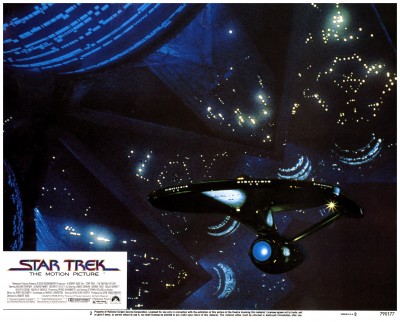 There was talk during the mid-seventies of a new television series entitled Star Trek Phase II with an all-new cast, but then Star Wars IV A New Hope (1977) and Close Encounters Of The Third Kind (1977) were released, and everyone in Hollywood was talking science fiction. Roddenberry’s modestly-budgeted television re-rash suddenly found itself with US46 million and given the full five-star feature film treatment from Paramount Studios, who wanted Star Trek The Motion Picture (1979) to be everything the original series could never be – big, impressive, expansive and effects-laden to the gills (Robert Abel was first hired to helm the effects but proved to be too slow and expensive, so maestro Douglas Trumbull was brought in to complete the job). Say what you like about the later Star Trek films, the money spent on the first big-screen voyage, is right up there for all to see.
There was talk during the mid-seventies of a new television series entitled Star Trek Phase II with an all-new cast, but then Star Wars IV A New Hope (1977) and Close Encounters Of The Third Kind (1977) were released, and everyone in Hollywood was talking science fiction. Roddenberry’s modestly-budgeted television re-rash suddenly found itself with US46 million and given the full five-star feature film treatment from Paramount Studios, who wanted Star Trek The Motion Picture (1979) to be everything the original series could never be – big, impressive, expansive and effects-laden to the gills (Robert Abel was first hired to helm the effects but proved to be too slow and expensive, so maestro Douglas Trumbull was brought in to complete the job). Say what you like about the later Star Trek films, the money spent on the first big-screen voyage, is right up there for all to see.
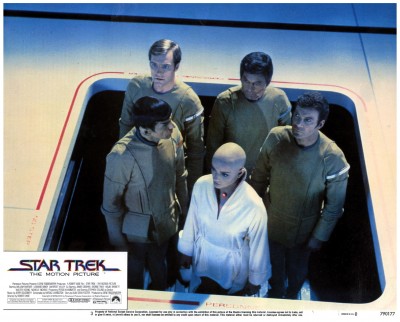 Starfleet communications station Epsilon IX detects an alien force hidden within a massive cloud of energy, moving through space towards Earth. We watch as the cloud destroys three Klingon warships along with Epsilon IX. Meanwhile on Earth, the starship Enterprise is undergoing a major refit while her captain, James T. Kirk (William Shatner) has been promoted to Admiral and Chief of Starfleet Operations. Being the only starship in intercept range, the Enterprise is dispatched to investigate the cloud entity, and Kirk insists on taking command and his old bridge crew: Doctor McCoy (DeForest Kelley), Scotty (James Doohan), Sulu (George Takei), Chekov (Walter Koenig) and Uhura (Nichelle Nichols). This pisses off Captain Willard Decker (Stephen Collins) no end, who has been overseeing the refit as its new commanding officer. The tension between Kirk and Decker increases when the admiral demonstrates his unfamiliarity with the new Enterprise.
Starfleet communications station Epsilon IX detects an alien force hidden within a massive cloud of energy, moving through space towards Earth. We watch as the cloud destroys three Klingon warships along with Epsilon IX. Meanwhile on Earth, the starship Enterprise is undergoing a major refit while her captain, James T. Kirk (William Shatner) has been promoted to Admiral and Chief of Starfleet Operations. Being the only starship in intercept range, the Enterprise is dispatched to investigate the cloud entity, and Kirk insists on taking command and his old bridge crew: Doctor McCoy (DeForest Kelley), Scotty (James Doohan), Sulu (George Takei), Chekov (Walter Koenig) and Uhura (Nichelle Nichols). This pisses off Captain Willard Decker (Stephen Collins) no end, who has been overseeing the refit as its new commanding officer. The tension between Kirk and Decker increases when the admiral demonstrates his unfamiliarity with the new Enterprise.
 Spock (Leonard Nimoy) soon arrives to take his station as science officer, and explains that while on his home world he felt a consciousness emanating from the cloud. The Enterprise intercepts the energy cloud and is attacked by an alien vessel within. A probe appears on the bridge, attacks Spock and abducts navigator Ilia (Persis Khambatta), replacing her with a robot twin, a probe sent by V’Ger to study and interact with the crew. Decker is distraught over the loss of Ilia, with whom he had a romantic history. He becomes troubled as he attempts to extract information from the robot twin, which has Ilia’s memories and feelings buried within. Spock takes a spacewalk to the alien vessel’s surface and attempts a telepathic mind-meld with it. In doing so, he learns that the vessel is V’Ger itself, a living machine. At the heart of the massive ship, V’Ger is revealed to be Voyager 6, a long-lost 20th century space probe.
Spock (Leonard Nimoy) soon arrives to take his station as science officer, and explains that while on his home world he felt a consciousness emanating from the cloud. The Enterprise intercepts the energy cloud and is attacked by an alien vessel within. A probe appears on the bridge, attacks Spock and abducts navigator Ilia (Persis Khambatta), replacing her with a robot twin, a probe sent by V’Ger to study and interact with the crew. Decker is distraught over the loss of Ilia, with whom he had a romantic history. He becomes troubled as he attempts to extract information from the robot twin, which has Ilia’s memories and feelings buried within. Spock takes a spacewalk to the alien vessel’s surface and attempts a telepathic mind-meld with it. In doing so, he learns that the vessel is V’Ger itself, a living machine. At the heart of the massive ship, V’Ger is revealed to be Voyager 6, a long-lost 20th century space probe.
 The damaged probe was found by an alien race of living machines that interpreted its programming as instructions to learn all that can be learned, and return that information to its creator. The machines upgraded the probe to fulfill its mission, and on its journey the probe gathered so much knowledge that it achieved consciousness. Spock realises that V’Ger lacks the ability to give itself a focus other than its original mission – having learned what it could on its journey home, it finds its existence empty and without purpose. Before transmitting all its information, V’Ger insists that the Creator come in person to finish the sequence. Realising that the machine wants to merge with its creator, Decker offers himself to V’Ger – he merges with the Ilia probe and V’Ger, creating a new form of life that disappears into another dimension. With Earth saved, Kirk directs Enterprise out to space for future missions.
The damaged probe was found by an alien race of living machines that interpreted its programming as instructions to learn all that can be learned, and return that information to its creator. The machines upgraded the probe to fulfill its mission, and on its journey the probe gathered so much knowledge that it achieved consciousness. Spock realises that V’Ger lacks the ability to give itself a focus other than its original mission – having learned what it could on its journey home, it finds its existence empty and without purpose. Before transmitting all its information, V’Ger insists that the Creator come in person to finish the sequence. Realising that the machine wants to merge with its creator, Decker offers himself to V’Ger – he merges with the Ilia probe and V’Ger, creating a new form of life that disappears into another dimension. With Earth saved, Kirk directs Enterprise out to space for future missions.
 Star Trek fans were extremely disappointed in this needlessly expensive epic when it was first released. While it has obvious serious faults (the special effects seem to be from another film, there are tedious stretches, the ending is incomprehensible) some consider it better than the original television series because it doesn’t have the phony moralism that characterised virtually every episode. There is also a sense that these characters are actually traveling through space (instead of being studio-bound) and that they understand the wonder of such an endeavour. Furthermore, these crew members don’t come across like policemen on their beat, but as real pioneers and defenders of our world. Unfortunately, the dialogue and acting are just as wooden as they always were in the original series.
Star Trek fans were extremely disappointed in this needlessly expensive epic when it was first released. While it has obvious serious faults (the special effects seem to be from another film, there are tedious stretches, the ending is incomprehensible) some consider it better than the original television series because it doesn’t have the phony moralism that characterised virtually every episode. There is also a sense that these characters are actually traveling through space (instead of being studio-bound) and that they understand the wonder of such an endeavour. Furthermore, these crew members don’t come across like policemen on their beat, but as real pioneers and defenders of our world. Unfortunately, the dialogue and acting are just as wooden as they always were in the original series.
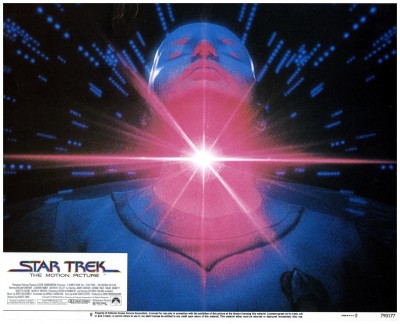 Enlisting veteran director Robert Wise (who specialised in bringing gargantuan projects like these to fruition on-time and on-budget) may have seemed a smart move, but it was actually a last-minute decision. A no-fuss studio-friendly gun-for-hire and ex-president of the Director’s Guild Of America, Wise had proved himself a jack-of-all-genres and an adept hand at science fiction. His classic The Day The Earth Stood Still (1951) still ranks among the best ever produced, and his underrated but absorbing adaptation of The Andromeda Strain (1971) remains a persuasively-told crackerjack thriller. Although written by Alan Dean Foster and Harold Livingston, it is a well-known fact that the script for Star Trek The Motion PIcture was loosely based on a few different Star Trek stories, primarily The Changeling and The Doomsday Machine. What’s not often mentioned is a big chunk of the film is lifted from the Robert Wise submarine movie Run Silent Run Deep (1955) in which a commander persuades the Navy Board to give him a new submarine, while his second-in-command resents his commander and the Navy Board for denying him command of the boat which he believes should rightfully have been his.
Enlisting veteran director Robert Wise (who specialised in bringing gargantuan projects like these to fruition on-time and on-budget) may have seemed a smart move, but it was actually a last-minute decision. A no-fuss studio-friendly gun-for-hire and ex-president of the Director’s Guild Of America, Wise had proved himself a jack-of-all-genres and an adept hand at science fiction. His classic The Day The Earth Stood Still (1951) still ranks among the best ever produced, and his underrated but absorbing adaptation of The Andromeda Strain (1971) remains a persuasively-told crackerjack thriller. Although written by Alan Dean Foster and Harold Livingston, it is a well-known fact that the script for Star Trek The Motion PIcture was loosely based on a few different Star Trek stories, primarily The Changeling and The Doomsday Machine. What’s not often mentioned is a big chunk of the film is lifted from the Robert Wise submarine movie Run Silent Run Deep (1955) in which a commander persuades the Navy Board to give him a new submarine, while his second-in-command resents his commander and the Navy Board for denying him command of the boat which he believes should rightfully have been his.
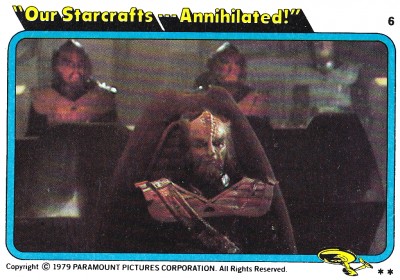 Robert Wise was always unhappy with the final cut of Star Trek The Motion Picture, which suffered from a ridiculously hurried post-production to meet an overly optimistic release date. All the usual fine-tuning, audience testing and trimming that most films enjoy, was not an option for Wise and editor Todd Ramsay. Finally, twenty-three years after the initial release of the film with a director’s cut made available on DVD, the truth was at last revealed: Robert Wise must have always wanted the film to be…really dull! Whilst undoubtedly an improvement in many respects, this ‘redux’ version with its remixed soundtrack and a handful of new special effects shots will provide some fun for Treksters but will likely prove to be an endurance test for the non-converted. While there’s no denying this cut is a definite improvement overall, the film still seems to strain for an epic grandeur it mostly can’t deliver. For instance, a scene where Kirk and a comparatively thin Scotty endlessly circle the newly refurbished Enterprise feels as overcooked and extended as it always did. While it’s interesting to see how many expressions of joy Shatner can provide whilst gazing at his beloved starship, for the rest of us, five-and-a-half minutes never felt so long!
Robert Wise was always unhappy with the final cut of Star Trek The Motion Picture, which suffered from a ridiculously hurried post-production to meet an overly optimistic release date. All the usual fine-tuning, audience testing and trimming that most films enjoy, was not an option for Wise and editor Todd Ramsay. Finally, twenty-three years after the initial release of the film with a director’s cut made available on DVD, the truth was at last revealed: Robert Wise must have always wanted the film to be…really dull! Whilst undoubtedly an improvement in many respects, this ‘redux’ version with its remixed soundtrack and a handful of new special effects shots will provide some fun for Treksters but will likely prove to be an endurance test for the non-converted. While there’s no denying this cut is a definite improvement overall, the film still seems to strain for an epic grandeur it mostly can’t deliver. For instance, a scene where Kirk and a comparatively thin Scotty endlessly circle the newly refurbished Enterprise feels as overcooked and extended as it always did. While it’s interesting to see how many expressions of joy Shatner can provide whilst gazing at his beloved starship, for the rest of us, five-and-a-half minutes never felt so long!
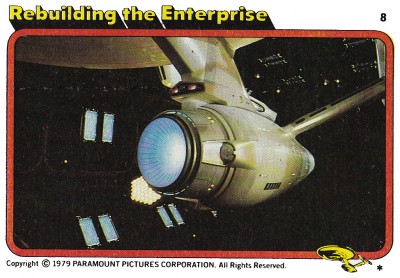 The original Star Trek series was always character based. The camaraderie between the actors made the show what it was but, despite being reunited for the first time, the crew look strangely uncomfortable revisiting their roles. Wise and his scriptwriters have traded the usual friendly rapport of Kirk and company to make Star Trek The Motion Picture often visually arresting but mostly plodding. Changing the series gaudy colour scheme (designed to exploit the novelty of newly introduced colour television) Wise, together with his art and costume department, went for a seriously neutral selection of sombre greys, tans and beige, and tends to make the film appear as dated as a seventies television chat show. Jerry Goldsmith‘s score has some fabulous moments when it’s not belting out that now-familiar fanfare (later utilised by Star Trek The Next Generation) which really gets a workout here but, despite all the high points and redux tinkering, this voyage still feels strangely unfinished.
The original Star Trek series was always character based. The camaraderie between the actors made the show what it was but, despite being reunited for the first time, the crew look strangely uncomfortable revisiting their roles. Wise and his scriptwriters have traded the usual friendly rapport of Kirk and company to make Star Trek The Motion Picture often visually arresting but mostly plodding. Changing the series gaudy colour scheme (designed to exploit the novelty of newly introduced colour television) Wise, together with his art and costume department, went for a seriously neutral selection of sombre greys, tans and beige, and tends to make the film appear as dated as a seventies television chat show. Jerry Goldsmith‘s score has some fabulous moments when it’s not belting out that now-familiar fanfare (later utilised by Star Trek The Next Generation) which really gets a workout here but, despite all the high points and redux tinkering, this voyage still feels strangely unfinished.
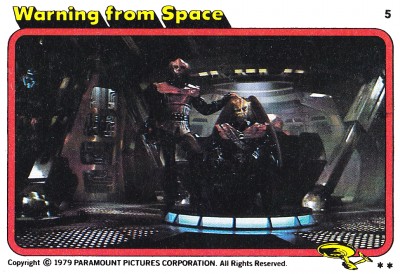 More interesting to fans might the special features that accompanied this particular DVD release. There’s a well-edited audio commentary with contributions from director Robert Wise, composer Jerry Goldsmith, actor Stephen Collins and effects supervisors Douglas Trumbull and John Dykstra. All provide very comprehensive coverage on their particular areas of involvement. There’s also an accompanying text commentary by Michael Okuda, co-author of The Star Trek Encyclopedia, who offers informative but rather dry facts for full immersion into the Trek universe. Three featurettes are also included: Phase II The Lost Enterprise discusses the on-off nature of the project which ultimately evolved into Star Trek The Motion Picture. Early screen tests are included for the new series-that-never-was including Persis Khambatta in a bald cap and a rejected Vulcan with a mullet haircut. Actress Majel Barrett-Roddenberry and commissioned screenwriter Harold Livingston also contribute to the subject.
More interesting to fans might the special features that accompanied this particular DVD release. There’s a well-edited audio commentary with contributions from director Robert Wise, composer Jerry Goldsmith, actor Stephen Collins and effects supervisors Douglas Trumbull and John Dykstra. All provide very comprehensive coverage on their particular areas of involvement. There’s also an accompanying text commentary by Michael Okuda, co-author of The Star Trek Encyclopedia, who offers informative but rather dry facts for full immersion into the Trek universe. Three featurettes are also included: Phase II The Lost Enterprise discusses the on-off nature of the project which ultimately evolved into Star Trek The Motion Picture. Early screen tests are included for the new series-that-never-was including Persis Khambatta in a bald cap and a rejected Vulcan with a mullet haircut. Actress Majel Barrett-Roddenberry and commissioned screenwriter Harold Livingston also contribute to the subject.
 A Bold New Enterprise is a thirty-minute retrospective documentary about the making of Star Trek The Motion Picture that includes asides from William Shatner, Walter Koenig, Stephen Collins, Robert Wise, Douglas Trumbull, Todd Ramsay, cinematographer Richard Kline and art director Harold Michelson. Most interesting perhaps are the comments from a young Jeffrey Katzenberg (now one of the three moguls who make up Dreamworks), an enthusiastic can-do type of person who took on the unenviable near-impossible mission of making sure the film was completed by its premiere date. Redirecting The Future is a fourteen-minute look at the making of the director’s cut, the changes that were made, and compares the new shots against the shots they replaced. There’s also the usual trailers, posters, storyboards, deleted scenes and out-takes, including eleven scenes from the extended 1983 television version, thoughtfully included in their 2.35:1 ratio. Kudos to Paramount for attempting to repair what is considered by many to be the second-weakest film in the entire franchise – now if they could only find enough money to throw at Shatner to fix Star Trek V The Final Frontier (1989)! And it’s with this thought in mind I’ll politely invite you to please join me next week when I have another opportunity to give your cinematic sensibilities a damn good thrashing with the ugly stick for…Horror News! Toodles!
A Bold New Enterprise is a thirty-minute retrospective documentary about the making of Star Trek The Motion Picture that includes asides from William Shatner, Walter Koenig, Stephen Collins, Robert Wise, Douglas Trumbull, Todd Ramsay, cinematographer Richard Kline and art director Harold Michelson. Most interesting perhaps are the comments from a young Jeffrey Katzenberg (now one of the three moguls who make up Dreamworks), an enthusiastic can-do type of person who took on the unenviable near-impossible mission of making sure the film was completed by its premiere date. Redirecting The Future is a fourteen-minute look at the making of the director’s cut, the changes that were made, and compares the new shots against the shots they replaced. There’s also the usual trailers, posters, storyboards, deleted scenes and out-takes, including eleven scenes from the extended 1983 television version, thoughtfully included in their 2.35:1 ratio. Kudos to Paramount for attempting to repair what is considered by many to be the second-weakest film in the entire franchise – now if they could only find enough money to throw at Shatner to fix Star Trek V The Final Frontier (1989)! And it’s with this thought in mind I’ll politely invite you to please join me next week when I have another opportunity to give your cinematic sensibilities a damn good thrashing with the ugly stick for…Horror News! Toodles!
 Horror News | HNN Official Site | Horror Movies,Trailers, Reviews
Horror News | HNN Official Site | Horror Movies,Trailers, Reviews
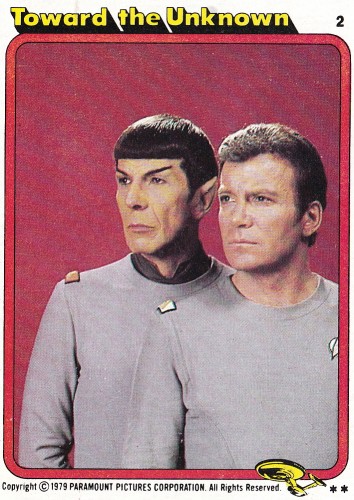

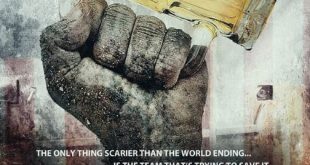
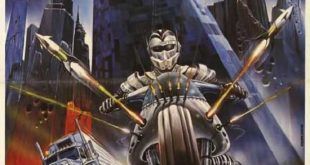


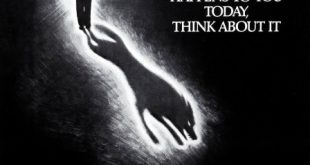
I remember pleading with my dad to see this when it opened on Christmas day back in 79′ and how we both fell fast asleep after about 40 minutes. Although repeated viewings haven’t made it any better for me your review makes me want to revisit it one more time and isn’t that what a good review ought to do?
Nice work Nigel! Live long and prosper my friend…
Hello, good evening, and thank you for your very kind comments, Mr Saint! No matter how bad a film is, I always try to find something good (or at least interesting) about it.
Like you, I was pretty darn excited when Star Trek The Motion Picture came out. The first time I saw the teaser-trailer (which was just the scene of Enterprise pulling out of dry-dock with Orson Welles’ voice-over telling us how important Star Trek was) I actually had tears in my eyes. Hmm, now that I think about it, Orson Welles makes sense, he probably did it as a favour to Robert Wise, who was the editor on Citizen Kane.
Although I recognised the film’s faults, I saw it five times on the big screen…well, four and a half. The fifth time I saw it, like you, I fell asleep about forty minutes in. And it’s on that sedating note I’ll bid you a good night and look forward to doing the zombie stomp with you again next week when I have the opportunity to lay at your feet another dead bird from the dodgy chicken shop known as Hollywood for…Horror News! Toodles!
Excellent job on this review, Nigel! I love this film and I love the DC from Wise even better. Goldsmith’s score, Trumbull’s FX and the grandeur of the story and characters all worked so well for me. My mother took me to see this when I was a kid and I know for certain that she was bored to death with it all but she wanted me to have a great experience and I did. I was on the edge of my seat the whole time.
Sure, it dragged a bit but what a great looking and sounding film this is. I was so geeked out at the time I even took my paperback to the theater. Once again, Nigel, fantastic job reviewing one of my favorite Trek films. Kudos on the background info too! I always wonder how “Phase II” would have been like. Thanks!